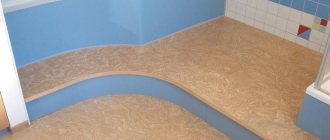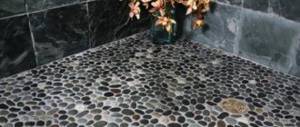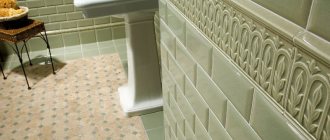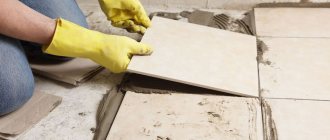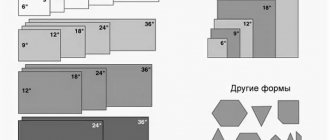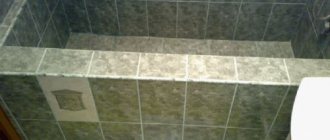Information on how to lay tiles on a wooden floor in a bathroom yourself is relevant when operating buildings with wooden floors. This article will consider the option of decorating a subfloor made of sheet materials (OSB, chipboard or plywood) and edged boards with tiles/porcelain tiles.
For the final floor covering made from tongue-and-groove boards on a slab floor, it is recommended to replace it with a screed, since this technology is much cheaper, both in production and in operation.
Is it possible to lay tiles on a wooden floor?
To cover a wooden base with ceramic tiles, the wood will have to be subjected to high-quality processing. First of all, the materials are incompatible due to radically different material properties. You can get to know him better in the table below.
| Property | Ceramics | Tree |
| Lifetime | Durable and stable material, destroyed only under heavy mechanical stress | Subject to various types of destructive processes, service life is noticeably shorter than that of ceramics |
| Moisture resistance | Does not change its composition and thickness under the influence of moisture | If there is an excess of moisture, wood greatly increases in size; if there is not enough moisture, it can dry out. |
| Application of glue | Any glue is suitable | It is recommended to avoid water-repellent glue, as it blocks the flow of oxygen to the wood surface, resulting in a shorter lifespan of the wood. |
Is it possible to lay tiles on a wooden floor? Yes, but very carefully. Combining ceramics and a wooden base is possible, but this process requires meticulous preparation and complex installation. Before moving on to the main type of work, the wood must be subjected to special treatment, protected with a waterproofing layer and all holes and cracks sealed.
Why is it undesirable to combine ceramics and wood?
Tiles and wood are materials with opposite properties. The low strength characteristics of wood are due to the fact that it is a completely natural material that requires a constant flow of oxygen and insulation from moisture.
It is important to ensure that the wooden covering is completely immobile so that the ceramic slab does not crack during installation. Otherwise, you will have to start the repair again.
Under the influence of moisture, a wooden structure can increase in size or dry out without moisture at all. When laying tiles, the main task of the master is to create a damping layer to ensure constant access of air and the required amount of moisture to the wooden base.
If the wood does not “breathe”, after a while it will begin to rot or become infected with fungus.
Waterproofing
Naturally, when choosing a finish for a bathroom floor, the question arises: how to keep the coating intact from constant contact with water that destroys wood?
Here you cannot do without high-quality waterproofing.
The process of waterproofing in a wooden house does not differ much from a similar procedure in brick houses.
Waterproofing is carried out using several layers of insulating film - usually no more than two, or in mixtures. If this is required, along with waterproofing the floor, you can use a film or mixture to insulate the walls (the film is raised from the floor by 20 cm or more). Afterwards we apply a layer of screed and complete the work with a fine finish. If desired, you can immediately install the underfloor heating system.
Waterproofing the bathroom floor
Of course, even taking into account improved waterproofing, we should not forget about the possible deformation of the floors. Using an antiseptic will help prevent water from getting into the wood fibers.
Features of installation on wood
Key points to pay attention to when laying ceramic tiles on a wooden floor:
- First of all, it is necessary to provide the wood with access to oxygen so that the material does not begin to rot and does not change in size, which can cause the tiles to crack.
- The base must be stationary so that the tiles lie flat and firmly.
- Loads must be evenly distributed over the entire surface, otherwise the materials will crack during installation.
Creating an insulating layer
The rigidity of the screed or tile adhesive is much higher than that of the wood used as a base. Therefore, between the tile and the floor there is a layer that compensates for the movements of the wood, and also forms a waterproofing layer.
When using a special multifunctional film, the shock-absorbing layer should be placed with the hard side against the tiles, and the elastic side against the boards. For them to breathe, the material must allow steam and air to pass through, but block the penetration of moisture.
Waterproofing can be rolled or liquid.
- The solid material is rolled out onto the floor and secured with tape.
- Drying oil or latex impregnation is applied to the wooden surface and the painting mesh is immediately laid.
USEFUL INFORMATION: Siphons for bathroom sinks: structure, types, installation
A damper against wood movement can be an elastic adhesive backing onto which the tiles are attached.
Preparation of tools and materials
Materials for laying tiles on wood:
- Glue.
- Water.
- Drawing materials.
- Grout for tiles.
- Materials for screed.
- Sealant.
Tools for laying tiles on wood:
- Bucket for diluting glue.
- Grinder or ceramic knife for cutting tiles.
- Crosses for tiles.
- Spatula or trowel.
- Notched trowel.
Preparing the base
Laying tiles should begin with preparatory work. Wood requires additional processing so that the tiles do not crack or deteriorate during installation. Not only the quality of the floor, but also its aesthetic appearance will depend on the quality of preparation of the base.
When processing wood, you should strictly follow all instructions in order to save yourself from the need for repeated repairs. After installing the wood, at least two years must pass (the shrinkage period lasts approximately this long) before you can begin laying ceramic tiles.
Checking the condition of the coating
The first thing you should take care of is checking the condition of the coating. If the installation of wood was completed a long time ago, after some time the material could begin to rot or dry out. It will be impossible to lay tiles on surfaces covered with a layer of fungi, mold and other bacteria.
Good condition of the base
Ceramic tiles can only be laid on a substrate in good condition. If no visible defects were found or you got rid of them in time, you can move on to the next stage of repair. First you need to remove the wooden base, and then carefully check the beams and joists for damage.
The distance between the lags should not exceed 50 cm, otherwise the material will not withstand the weight of the ceramic tiles.
The joists are in good condition, but the decking is damaged.
Checking the condition of the lag is very simple. The wooden base will have to be completely disassembled to provide access to hidden parts. It is better to replace damaged flooring with cracks, swelling or fungus with a new one, since restoring the old one will be problematic.
The condition depends on their evenness. Balance disappears if the logs sag under the weight of damage. To ensure the strength of the base, the space between the logs is filled with expanded clay, which repels moisture well and does not cause the boards to rot. A layer of thermal insulation is placed on top to protect the wood from overheating.
Poor floor condition
If the condition of the floor is unsatisfactory, the base will have to be replaced or damaged areas removed using a machine. What signs can be used to judge the unsatisfactory condition of the floor:
- The presence of fungus, mold and other bacteria. Infestation of wood causes it to become softer and open.
- The appearance of wood-boring beetles provokes the destruction of wood.
- Some areas began to rot. You can test the wood for strength in the following way: stick an awl into a certain area. If it fits easily without visible effort, the damaged elements should be removed as quickly as possible, otherwise laying tiles on such a surface will be impossible.
If the condition of the floor is unsatisfactory, it is necessary to remove all damaged elements and treat the wood with a special antiseptic solution to prevent the appearance of new destructive bacteria.
An additional layer of waterproofing may be required.
Antiseptic treatment
Antiseptic treatment is necessary to protect the tree from fungus and bacteria. To achieve maximum results, you should reapply the product (up to 5 times) as soon as the first part dries. The most popular antiseptic is hot drying oil. The next layer can be applied only after the surface is no longer sticky from the previous one.
The antiseptic properties of drying oil directly depend on its temperature. During application, it should be as hot as possible in order to destroy harmful bacteria as quickly and effectively as possible.
Ceramic tiles for the bathroom: application on wood surfaces
Installing tiles in a frame or wooden structure is a serious and very difficult process. Certain conditions in these rooms differ slightly from the most common ones, due to the non-standard parameters of the tree:
- Shrinkage. Wooden buildings shrink significantly over time, and this specifically affects the condition of the floor, walls and ceiling.
- Dynamism. When moisture and ambient temperature change, wood can shrink or expand, changing shape and volume.
- Sensitivity to damage. In conditions of stable, very high humidity, the tree admires various microbes: spots of rot and mold, and fungal diseases may appear on it. Various insects can also cause significant damage to wood. To eliminate the expected pathological changes, the material must undergo a detailed disinfecting finish, and then be coated with some kind of protective agent.
- Moisture sensitivity. Even a slight increase in moisture can have a negative impact on the quality of the material, especially in rooms such as the kitchen and bathroom. They must provide excellent hydro- and vapor barrier.
It must be remembered that it is not necessary to carry out finishing work in a recently built wooden house. Before you begin finishing with tiles or other materials, you must wait the required period until the period of active shrinkage of the structure ends. Due to this, you will be able to prevent displacement of the installed coating, which means you will maintain its original appearance. Installing tiles on walls or floors made of wood materials is considered not a whim, but a working necessity. Because of this, it is so necessary to know and follow the rules for performing work of this kind.
Leveling the surface
After the antiseptic has dried, you can proceed to leveling the working surface. The wood should be cleaned of old varnish, paint and other coatings. Professional craftsmen offer three convenient ways to remove old coating:
- Exposure to hot air. A hair dryer set to a temperature of more than 200 degrees is suitable for this purpose. As soon as the paint and varnish begin to swell, they can be removed with a construction spatula. The main thing is not to overheat the wood so that it does not deteriorate.
- Mechanical cleaning with a spatula or sandpaper takes a lot of time, but is suitable for beginners.
- The use of chemicals quickly and effectively removes old coating, but is not cheap.
After leveling the surface of the board, you should inspect it again for damage.
Plywood or chipboard
Before you begin repair work, you should familiarize yourself with the tips on how to lay a wooden floor made of DSP correctly:
- Before laying the tiles, it is necessary to secure the DSP sheets. The joints of the plywood should not coincide with the joints of the joists, otherwise the wooden base will fail under the influence of the weight of the ceramic tiles. The suitable distance for plywood sheets is 25-30 cm.
- All seams must be treated with a special solution and then sanded well.
- Apply the adhesive solution to the surface of the plywood and the tile itself on the back side.
- The level of the tiles should be determined using a building level.
The main advantage of DSP is the ability to create a perfectly flat surface. A rough base will be required.
Moisture-resistant drywall
Moisture-resistant drywall requires special preparation. The material is quite fragile, so before laying the tiles you will need to construct special guide strips, the distance between which should not be less than half a meter. Otherwise, the tiles will begin to sag and damage the base.
On both sides, drywall is treated with a primer solution to increase strength.
Dry screed
Dry screed is suitable for moisture-resistant plasterboard and fiberboard panels. It should not be used in rooms with high humidity: bathrooms, kitchens, since expanded clay absorbs air well. Dry screed is prepared from various types of dry materials: expanded clay (has good characteristics), perlite, vermiculite.
Main advantages:
- Does not require drying.
- Production speed is about two days.
- It retains heat well, which is provided by expanded clay.
- High level of sound insulation.
Wet screed
Wet screed is prepared from cement-sand mortar. It dries out in about 2-3 days, during which time all repair work will have to be postponed. Fiberglass and glue can be added to the wet screed mixture to increase the strength and elasticity of the cement mortar.
It is important to fill the screed with an even compound to facilitate the process of laying the tiles.
Sealing cracks and joints
Laying an insulating layer allows you to seal all the cracks and joints. It is better to choose non-hygroscopic materials to prevent moisture from appearing and further weakening of the wood, as well as to protect the material from infection by fungus and bacteria. The material should be lightweight to prevent the material from sagging.
The most suitable option is extruded polypropylene foam of synthetic origin or mineral wool. The material is not cheap and does not allow air to pass through well, otherwise its properties correspond to the type of repair work. The insulation is laid on top of the waterproofing layer.
Application of "warm floor" technology
For a wash room in a wooden building, it is recommended to install a heated floor system. You can hide communication pipes and wires under it. The design, based on infrared film, does not require a concrete screed.
In addition to creating a comfortable temperature regime, electric heating of the floor covering in the bathroom serves to remove dripping moisture and dry the room.
Any facing material can be laid on the top layer, which represents the finishing. The only condition is that it must have good thermal conductivity. Otherwise, more energy will be spent on heating.
Choosing the right adhesive
It is equally important to choose the right glue. Preference should be given to glue, which is prepared from a dry construction mixture. Main types of tile adhesive:
- Leveling. Copes well with uneven surfaces up to 5 mm deep. Contacts well with moisture.
- Elastic. Suitable for laying tiles on non-solid materials - wood, plywood, drywall. Can be used for heated floors.
- Heat resistant. Suitable for heated floors.
We also recommend watching - Ceresit tile adhesive: varieties and features
Laying technology
After the wooden covering is ready, you can proceed to the actual laying of the tiles. Technology for laying porcelain stoneware on a wooden floor:
Lay the tiles on the floor without using adhesive to see if there is enough material and how it will look better.
- Most likely you will have to do some trimming. For this purpose, it is better to use a tile cutter, a ceramic knife or a diamond-coated grinder.
- You should start laying tiles from the center. This area should be illuminated as much as possible, since usually the central area is not covered by furniture and interior items, and is therefore visible to prying eyes.
- To lay the tiles evenly, you should make special marks on the floor. To begin with, draw diagonals from opposite corners and find the point of their intersection. Through this point, divide the floor into 4 equal sections.
- Dilute the glue, strictly following the instructions. Using a spatula, apply it to the floor and to the back of the tiles.
- Gently press the tile, tapping it with the handle of a spatula for strength. The size of the spatula should be selected in accordance with the dimensions of the tile, for a large one - 0.8 mm, for a small one - smaller.
- Lay whole pieces of tile first, starting from the middle. Leave undercuts on edges and in blind areas covered by furniture.
- To ensure that the tiles are laid in even rows, small crosses must be installed at the joints. If you don't have them, you can use regular matches. It is important to control the laying of tiles using a building level.
- If any part of the tile begins to “sink”, you need to carefully remove it with a spatula, add the missing mortar and lay it again.
Before the glue has completely dried, use a damp sponge or cloth to carefully remove any remaining glue.
Choosing the best option for flooring
For a new house, where the covering of each room is made of wood: teak, larch, oak or pine, installing a tile floor in the bathroom is not recommended. The fact is that the original coating must undergo natural shrinkage, which can take several months, or even years. Therefore, if during the construction of a house it was decided to lay floors in the room and in the bathroom from larch, then such surfaces can simply be treated with a high-quality antiseptic. The larch covering, in the presence of well-designed ventilation, is very durable especially at high humidity. In addition, larch floors are easy to clean and have excellent heat capacity. When treated with high-quality waterproof paint, they will last for decades.
If the desire to make a bathroom floor from tiles remains, then let’s analyze the possible options for the coating material:
- Porcelain tiles. Porcelain tiles are characterized by good heat capacity, practicality in operation, and - most importantly - almost zero water absorption. Using combinations with a rich range of colors, porcelain tiles can be easily matched to the color of the walls, bathtub, and floors in the room or hallway.
- Tile. It is considered the most economical option to install tiles over wooden floors. The porosity of the tiles somewhat improves the conditions for natural air exchange between the wood and other surfaces of the room. But - only for larch coverings.
- Ceramics. In terms of its performance indicators, it occupies an intermediate position between porcelain stoneware and tiles. Although, in particular, ceramic floors are much less slippery than tiled floors.
- Granite. The most durable, durable, mechanical and wear-resistant coating. But also the most costly from a financial point of view. And then - if there are floors in the bathroom made of expensive larch, is it worth covering them with equally expensive granite tiles?
Comparative characteristics of the consumer properties of tiles from the above materials:
- Material Heat capacity, kJ/kg?K Mechanical strength, GPa Water absorption,% Chemical resistance against aggressive environments
- Granite 0.8 0.26 0.06 ++
- Porcelain tiles 0.88 0.22 0.05 ++
- Tile 0.75 0.13 0.15 +
- Ceramics 0.84 0.16 0.3 +
Final processing
Until the adhesive solution has completely set, the tiles can be adjusted and leveled. The final appearance of the floor will be achieved after applying grout - a special solution that will fix the result and prevent oxygen from softening the glue.
For light-colored tiles, it is better to choose transparent or matching grout so that the two colors do not contrast with each other.
When the grout dries, its excess can be removed with a damp cloth or sponge. It is better not to walk on the floor for some time and protect it from mechanical stress so that the materials fit properly.
Advice from the experts
Some tips from experts on laying tiles on a wooden floor:
- If you decide to lay ceramic tiles on a wooden base, wait until at least two years have passed since its installation, since minor movements of the base are still occurring at this time. Otherwise, the tiles may crack during installation.
- The safest way to heat drying oil is to keep it in a container directly above the stove. It is worth preparing a piece of tarpaulin in advance to extinguish the flame if necessary.
- To improve the adhesion of the adhesive to the tiles, apply furrows in different directions.
- The glue dries very quickly, so it is advisable to dilute it for laying each square meter separately.
Wood and ceramics are materials that do not get along well with each other. But, following some recommendations, even a novice master can easily lay ceramic tiles on a wooden base, without the help of a professional. If you are not sure that you can do it yourself, we recommend watching a video on how to lay ceramics on wood.

